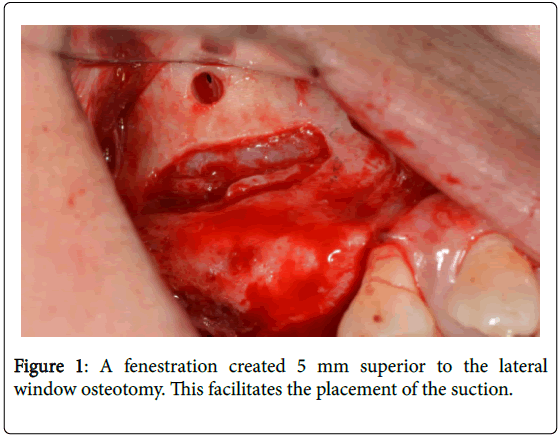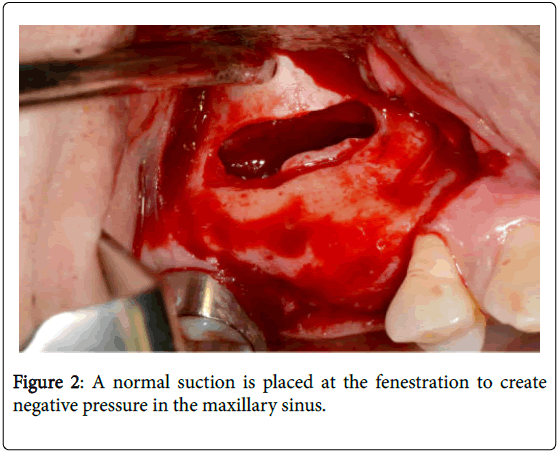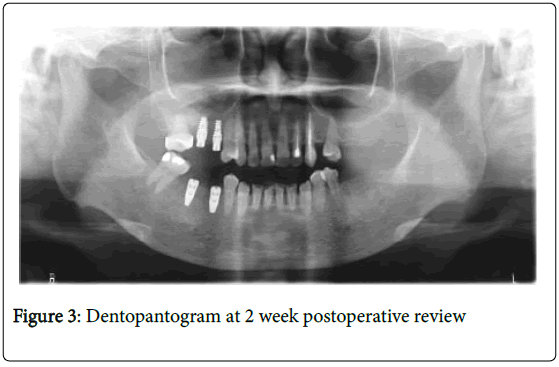Case Report Open Access
A Novel and Predictable Way for Maxillary Sinus Elevation: The Lateral Window Fenestrated Corticotomy (LFC) Technique
Albert MHL* and Bertrand SCC
National Dental Centre, Singapore
- *Corresponding Author:
- Albert MHL
National Dental Centre, 2nd Hospital Drive
168938, Singapore
Tel: +656324 8802
E-mail: albert.lee.m.h@ndcs.com.sg
Received: September 24, 2015 Accepted: January 29, 2016 Published: February 15, 2016
Citation: Albert MHL, Bertrand SCC (2016) A Novel and Predictable Way for Maxillary Sinus Elevation: The Lateral Window Fenestrated Corticotomy (LFC) Technique. Dent Implants Dentures 1:102. doi:10.4172/2572-4835.1000102
Copyright: © 2016 Albert MHL, et al. This is an open-access article distributed under the terms of the Creative Commons Attribution License, which permits unrestricted use, distribution, and reproduction in any medium, provided the original author and source are credited.
Visit for more related articles at Journal of Dental Science and Medicine
Abstract
Background: Maxillary sinus elevation is a procedure done to increase the subantral vertical bony dimension to aid implant placement. A common complication arising from this is the perforation of the sinus (Schneiderian) membrane. Purpose: This case report aims to introduce a novel and predictable way of elevating the Schneiderian membrane. Method: The clinical use of the Lateral Window Fenestrated Corticotomy (LFC) technique is illustrated in this case report. Interpretation: It reduces the clinical chance of a membrane perforation and reduces procedural time without need for any additional equipment.
Keywords
Maxillary sinus elevation; Sinus lift
Introduction
Maxillary sinus elevation and augmentation is a procedure done to increase the subantral vertical bony dimension for placement of implants. It was first described by Boyne in 1980 [1] and Tatum in 1986 [2]. The sinus lift is generally a safe and predictable procedure. Nevertheless there are complications as with all surgical procedures. The complications include perforation of the sinus membrane, hemorrhage, infection, acute and chronic sinusitis. The most common complication that arises is the perforation of the sinus (Schneiderian) membrane with a reported prevalence between 7% and 44% [3].
Maintaining the integrity of the sinus membrane during a sinus lift procedure is essential in achieving a predictable outcome. Perforation usually happens during elevation as the membrane lining is still attached to the maxillary sinus walls and floor. Perforation could potentially result in bacterial infection, compromise of the sinus health and function with the subsequent graft failure. Consequently, various techniques have been devised to reduce the risk of membrane perforations. These techniques include the usage of piezoelectric instruments, hydraulic pressure and nasal suction [4-6].
Aim
The objective of this report is to describe a novel and predictable technique. The technique results in a predictable elevation of the attached Schneiderian membrane from the walls and floor. This technique is used during lateral window approach and utilizes the principle of negative pressure to assist in the elevation of the Schneiderian membrane during elevation. This technique is named Lateral window Fenestrated Corticotomy (LFC).
Case Report
The involved patient needed implants at #15 and #16 with a concurrent sinus lift. The subantral bone height (at the planned prosthetic position of #15 and #16) is 9 mm and 6 mm respectively. It was decided that a sinus elevation is required via a lateral window approach to place implants of 10 mm in height. The decision is based on the ITI recommendation for #16 [7,8]. Therefore, the same window is extended to #15 for increased visibility and enhanced predictability. The surgery was performed under local anesthesia.
The patient was cleansed and draped. Local anesthesia was administered via buccal and palatal infiltration with Mepivacaine 2% with 1:80,000 adrenaline. A full thickness buccal mucoperiosteum flap was raised to expose the lateral wall of the right maxillary sinus (Figure 1). Maxillary site markings were done to outline subantral bone height and the intended grafted height and the edentulous span. Osteotomy was performed with a round bur size 2 to create a window in the lateral wall as dictated by the site markings. The bone of the window was carefully teased away and retained. This revealed an intact sinus membrane. The surrounding Schneiderian membrane was detached carefully from the walls without elevation. A surgical round bur size 8 was used to create a fenestration (at least) 5 mm superior to the window (Figure 1). The sinus membrane was intentionally perforated in this fenestration. A surgical suction tip was then slotted into this fenestration to create a negative pressure in the sinus (Figure 2). The size of the fenestration should approximate the size of the suction tip to obtain a snug connection. The suction was connected to the fenestration. The membrane was elevated off the sinus walls and floor with relative ease after creating a negative pressure in the sinus via the suction. Most of the lining lifted spontaneously from the walls and floor (Figure 2). A resorbable collagen membrane (Bio-Gide; Geistlich, Pharma AG, Wolhusen, Switzerland) was placed below the elevated Schneiderian membrane. Implants were placed in at #15 and #16 with two 4.3 mm × 10 mm Nobel Active TM implants (Nobel Bio care, Göteborg, Sweden). They registered good primary stability. The space created was grafted with xenografts (Bio-Oss; Geistlich, Pharma AG, Wolhusen, Switzerland) and the retained window bone was replaced. Bio-Gide membrane was then placed over the retained window bone. Healing abutments were placed as there was good primary stability. The site was then closed primarily with Prolene 6-0.
The patient was reviewed 2 weeks after the procedure. The postoperative phase was uneventful. There were no clinical signs of sinusitis or wound infection. A dentopantogram (DPT) was taken. It displayed a classical dome-shaped radio-opacity apical to the implants representing the area of sinus elevation and grafting (Figure 3).
Discussion
The LFC technique utilizes the principle of negative pressure within the maxillary sinus to elevate the membrane. This is generated by the suction placed in the iatrogenic fenestration. This effect is similar to that produced by a reverse Valsalva maneuver in which rapid inhalation of air causes an increase in negative air pressure [6]. The negative pressure allows the sinus membrane to be elevated with relative ease. Most of the membrane spontaneously lifts from the walls after the initial detachment.
In this technique, a fenestration is created in a superior position at least 5 mm away from the window. The Schneiderian membrane is intentionally perforated. This perforation is not accessible through the osteotomised window. Therefore, there is no possibility that the graft materials in the elevated sinus can enter the sinus via the perforated site. The two considerations for the position of the iatrogenic fenestration are to ensure that there is sufficient distance to prevent direct communication with the lateral sinus window and close proximity without extension in the relieving incision. The first consideration decreases the incidents of complications. The second consideration result in less post-operative discomfort.
The LFC technique is similar in principle to the nasal suction technique described by Ucer [6] where a nasal suction was placed into the ipsilateral side of the patient’s nose during sinus lift. The added advantage of the LFC technique is that it is more comfortable for the patient. There is no instrument in the nose. The nasal lining is sensitive to stimulation and instrumentation in the nose may not be tolerable for a conscious patient. Moreover, there is no need for an additional suction unit. One suction unit is used throughout the surgery for the creation of a negative pressure and removal of fluids/blood form the surgical field. An additional suction unit is required for the nose to prevent cross contamination of the surgical field in the nasal suction technique. Therefore, these are the advantages of the LFC technique.
There are several surgeons who recommend patient to take a deep breathe while elevating the sinus floor. It also utilises the principles of negative air pressure. This creates a negative pressure in the sinus which lifts up the membrane. However the duration of breathe is limited by the lung capacity and function of the patient. No patient can continuously inhale without exhaling. Comparatively, the LFC technique is able to supply a continuous negative pressure which results in a more sustainable environment for the elevation of the Schneiderian membrane. The negative pressure that is generated by the suction is usually greater in magnitude than that of the patient’s part. Hence, the LFC technique will result in a more predictable and sustained elevation of the Schneiderian membrane.
Conclusion
The LFC technique creates an intentional perforation in the sinus membrane to generate negative pressure within the sinus to aid in the membrane elevation from the sinus walls. It is comfortable for the patient and does not appear to cause any undue side effects. In tandem, it reduces the clinical chance of a membrane perforation and clinical time for the sinus elevation. Likewise, it does not require additional instruments. The author hopes to share the LFC technique as a safe and predictable approach to lateral window sinus elevation.
Acknowledgements
The authors would like to acknowledge the skills and innovation of A/Prof Loh Fun Chee in the description of this new technique. The authors reported no conflicts of interest related to this study.
References
- Boyne PJ, James RA (1980) Grafting of the maxillary sinus floor with autogenous marrow and bone. J Oral Surg 38: 613-616.
- Tatum H Jr (1986) Maxillary and sinus implant reconstructions. Dent Clin North Am 30: 207-229.
- Boffano P, Forouzanfar T (2014) Current concepts on complications associated with sinus augmentation procedures. J CraniofacSurg 25: e210-212.
- Chen L, Cha J (2005) An 8-year retrospective study: 1,100 patients receiving 1,557 implants using the minimally invasive hydraulic sinus condensing technique. J Periodontol 76: 482-491.
- Peivandi A, Bugnet R, Debize E, Gleizal A, Dohan DM, et al. (2007) Piezoelectric osteotomy: applications in periodontal and implant surgery. Rev StomatolChirMaxillofac 108: 431-440.
- Ucer TC (2009) Use of negative air pressure by nasal suction during maxillary sinus floor lift: audit of 13 consecutive sinus grafts. Br J Oral MaxillofacSurg 47: 151-152.
- Zitzmann NU, Schärer P (1998) Sinus elevation procedures in the resorbed posterior maxilla: Comparison of the crestal and lateral approaches. Oral Surgery, Oral Medicine, Oral Pathology, Oral Radiology, and Endodontology 85: 8-17.
- Katsuyama H, Jensen SS (2011) Sinus Floor Elevation Procedures. In. Chen S, Buser D, Wismeijer D (eds).(5th Edn) ITI Treatment Guide, Quintessence Publishing Co, Ltd, Germany.
Relevant Topics
Recommended Journals
Article Tools
Article Usage
- Total views: 12045
- [From(publication date):
December-2016 - Jul 17, 2025] - Breakdown by view type
- HTML page views : 11071
- PDF downloads : 974



